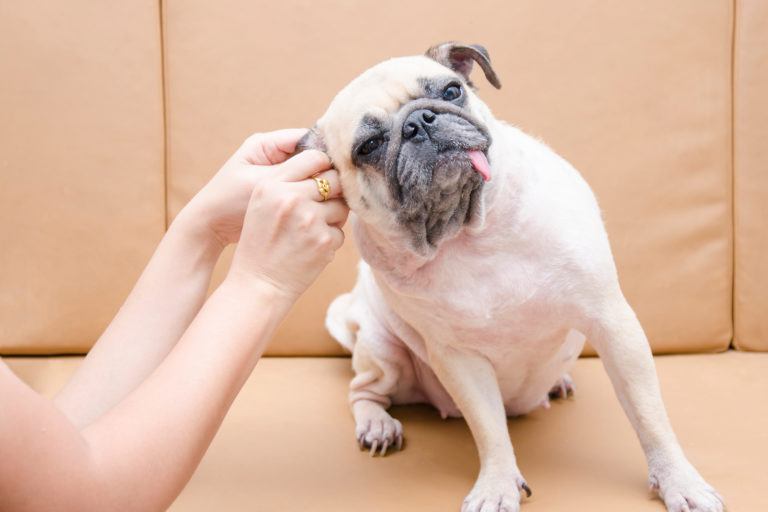
Quick Tips
- Use precautionary measures.
- Scrub up to help prevent dog ear infections.
- Choose the correct dog ear-cleaning solution.
- Squirt the ear-cleaning solution into the dog ear.
- Massage the dog ear cleaner into the ear.
- Remove the excess gunk.
Having had a Black Labrador mix or two in my lifetime, I’ve cleaned some dog ears in my past. Not only do Labs have those big, floppy ears that love to trap bacteria in them, but they’re also prone to leaping gleefully into bodies of water with no regard for sanitation. But my Labs have always had that characteristically good nature that make cleaning swamp goo out of their ears a pleasure. Almost. Each breed and each individual dog is going to have different health issues to watch out for and a different attitude about ear cleaning.
Because of this, you should always consult a veterinarian first. Your dog’s veterinarian can recommend the best dog ear cleaning solution for your particular dog, can examine your dog for any health problems, such as ear mites or ear infections, and can also tell you how often you should be cleaning your dog’s ears. This will help you avoid harming your dog, or causing issues with a sensitive part of their bodies. Since your Fluffy can’t tell you what hurts and what does not, keep in contact with your veterinarian, bring your dog in for regular exams, and stay away from the bitey parts during cleanings.
Steps to Cleaning Dog Ears
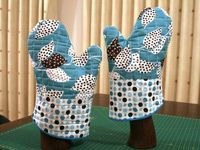 Use precautionary measures. Of course Fluffy is super sweet and would never, ever bite you, right? Well, no matter how sweet and loving your dog is, any dog can startle and nip (or ferociously attack) when frightened, confused, or in discomfort. Make sure that you use protective measures every time you clean your dog’s ears. This may include using a comfortable muzzle, having someone gently restrain the dog’s head, or standing behind your dog’s shoulders and reaching forward when cleaning. Preventing dog biting or dog scratching is always much better than treating it afterward.
Use precautionary measures. Of course Fluffy is super sweet and would never, ever bite you, right? Well, no matter how sweet and loving your dog is, any dog can startle and nip (or ferociously attack) when frightened, confused, or in discomfort. Make sure that you use protective measures every time you clean your dog’s ears. This may include using a comfortable muzzle, having someone gently restrain the dog’s head, or standing behind your dog’s shoulders and reaching forward when cleaning. Preventing dog biting or dog scratching is always much better than treating it afterward.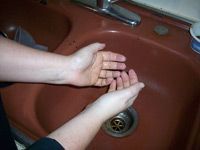 Scrub up to help prevent dog ear infections. If you’re sticking dirty fingers into your dog’s ears, then it certainly defies the point of ever cleaning their ears in the first place. So make sure that you scrub up your hands very well before you begin the cleaning. Use an unscented soap and scrub for at least thirty seconds. Make sure your nails are clear, as bacteria love to hide under there. Do not use perfumes or lotions before cleaning your dog’s ears. And, for additional sanitation as well as guarding against the yucky factor of sticking your fingers into a dirty dog ear, feel free to use a pair of new and sterile rubber gloves. Dog ear goo doesn’t come off fingers easily.
Scrub up to help prevent dog ear infections. If you’re sticking dirty fingers into your dog’s ears, then it certainly defies the point of ever cleaning their ears in the first place. So make sure that you scrub up your hands very well before you begin the cleaning. Use an unscented soap and scrub for at least thirty seconds. Make sure your nails are clear, as bacteria love to hide under there. Do not use perfumes or lotions before cleaning your dog’s ears. And, for additional sanitation as well as guarding against the yucky factor of sticking your fingers into a dirty dog ear, feel free to use a pair of new and sterile rubber gloves. Dog ear goo doesn’t come off fingers easily.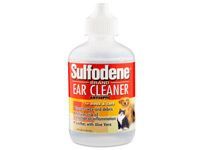 Choose the correct dog ear-cleaning solution. While there are natural remedies for cleaning dog ears, each animal has a different ear issue. It’s best to first discuss which ear-cleaning solution to use for your pet with a veterinarian or veterinary technician. Your dog may have a more serious ear issue, such as an ear fungus, ear mites, or an ear infection, and applying the wrong chemical could cause further discomfort or damage to the ear or your dog’s hearing. And since Fluffy can’t tell you if it hurts,or of any other symptoms of a dog ear problem, it’s best to have a professional help you pick the right cleaning solution. That same professional can also tell you when and how often you should be cleaning your dog ears.
Choose the correct dog ear-cleaning solution. While there are natural remedies for cleaning dog ears, each animal has a different ear issue. It’s best to first discuss which ear-cleaning solution to use for your pet with a veterinarian or veterinary technician. Your dog may have a more serious ear issue, such as an ear fungus, ear mites, or an ear infection, and applying the wrong chemical could cause further discomfort or damage to the ear or your dog’s hearing. And since Fluffy can’t tell you if it hurts,or of any other symptoms of a dog ear problem, it’s best to have a professional help you pick the right cleaning solution. That same professional can also tell you when and how often you should be cleaning your dog ears.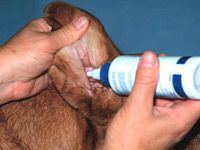 Squirt the ear-cleaning solution into the dog ear. With your dog comfortably positioned and you positioned safely behind his or her shoulders (and NOT standing directly in front by the toothy part), slowly squirt the ear-cleaning solution into the ear canal. Most products will come already in a squeeze bottle for proper flow and all that. Just be sure to carefully insert the tip of the bottle only a little way into the ear, just enough to direct the fluid into the ear canal. Don’t force it, as it could damage your dog’s ear. Once a small amount of the fluid is squeezed into the dog’s ear, be prepared for forceful head shaking and possible flying droplets of ear solution.
Squirt the ear-cleaning solution into the dog ear. With your dog comfortably positioned and you positioned safely behind his or her shoulders (and NOT standing directly in front by the toothy part), slowly squirt the ear-cleaning solution into the ear canal. Most products will come already in a squeeze bottle for proper flow and all that. Just be sure to carefully insert the tip of the bottle only a little way into the ear, just enough to direct the fluid into the ear canal. Don’t force it, as it could damage your dog’s ear. Once a small amount of the fluid is squeezed into the dog’s ear, be prepared for forceful head shaking and possible flying droplets of ear solution. Massage the dog ear cleaner into the ear. After squirting a strange-smelling, really cold fluid into an ear canal that is possibly infected and hurting, this is the easy part. The shock is over. Now you simply have to distribute the fluid evenly in the ear by massaging it. Using your fingers, gently rub at the outside base of the dog ear until the fluid is distributed. I am happy to say that this is the part that sometimes can even elicit a good tail thump or two from your dog as it doesn’t resemble medical treatment so much as loving affection.
Massage the dog ear cleaner into the ear. After squirting a strange-smelling, really cold fluid into an ear canal that is possibly infected and hurting, this is the easy part. The shock is over. Now you simply have to distribute the fluid evenly in the ear by massaging it. Using your fingers, gently rub at the outside base of the dog ear until the fluid is distributed. I am happy to say that this is the part that sometimes can even elicit a good tail thump or two from your dog as it doesn’t resemble medical treatment so much as loving affection.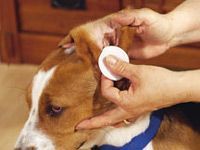 Remove the excess gunk. Using sterile cotton balls or gauze pads, gently (very gently!) wipe out the excess fluid. That dog ear goo can be plentiful and comes in a wide array of colors. Be sure to check with your vet if there is a substantial amount of ear goo, or if the color is bloody or any sort of neon color. This may mean that your dog has an infection and should be brought to the vet immediately. If not, keep on gently swabbing the inside of the ear with the cotton balls. Do NOT use Q-tips. The hard stick part can puncture or rupture your dogs ear canal or ear drum, which is both agonizingly painful and can permanently hurt your dog. Always use sterile, all natural cotton that is flexible and soft.
Remove the excess gunk. Using sterile cotton balls or gauze pads, gently (very gently!) wipe out the excess fluid. That dog ear goo can be plentiful and comes in a wide array of colors. Be sure to check with your vet if there is a substantial amount of ear goo, or if the color is bloody or any sort of neon color. This may mean that your dog has an infection and should be brought to the vet immediately. If not, keep on gently swabbing the inside of the ear with the cotton balls. Do NOT use Q-tips. The hard stick part can puncture or rupture your dogs ear canal or ear drum, which is both agonizingly painful and can permanently hurt your dog. Always use sterile, all natural cotton that is flexible and soft.
Dog Ear Infections
Many dogs suffer from ear infections. While all dogs can get ear infections, dogs with longer, floppy ears, such as Retrievers and Labradors, are more prone to them. Those long ears (and sometimes even the short ears) trap bacteria and various crud in the ear which can lead to a dog ear infection. Keeping your dog’s ears clean is an important part of helping to prevent infections. And if your dog’s ears are infected, cleaning them will allow the medicine in so that the infection can be properly treated. Symptoms of a dog ear infection include head shaking, scratching at the ears, poor balance, difficulty hearing, and a bad odor coming from the ear. Simply cleaning the dog ear will not treat or cure a dog ear infection. The dog must be brought to a vet in order to cure it. The vet will likely send you home with a dog ear cleaner to use before you apply the medicine daily. Yep, you must really love your doggie.
Dog Ear Cleaning Products
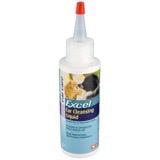 Dog ear-cleaning solution. There are many products available to help you clean your dog’s ears. Many are available over the counter and online, but it’s best to talk this over with your dog’s veterinarian first. He or she can tell you what to use to clean your dog’s ears and how often to use it, and can spot any medical problems your dog may have. The vet may also have suggestions for at-home, natural remedies for dog ear cleaning that may be a cheaper or healthier alternative to commercial products. Once you’ve spoken to your vet, you can check out the wide variety of dog ear cleaners sold on Amazon.
Dog ear-cleaning solution. There are many products available to help you clean your dog’s ears. Many are available over the counter and online, but it’s best to talk this over with your dog’s veterinarian first. He or she can tell you what to use to clean your dog’s ears and how often to use it, and can spot any medical problems your dog may have. The vet may also have suggestions for at-home, natural remedies for dog ear cleaning that may be a cheaper or healthier alternative to commercial products. Once you’ve spoken to your vet, you can check out the wide variety of dog ear cleaners sold on Amazon.
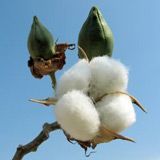 Cotton. All natural, unscented, and dye-free cotton is the perfect material to follow up the dog ear-cleaning solution. It won’t cause irritation the way a dyed or scented material could, it’s cheap and readily available, and you should have it on hand for medical purposes for people too. Use cotton balls or cotton pads but never Q-tips, as the stick part could hurt your dog’s ears. Yep, cotton’s not just for underpants anymore.
Cotton. All natural, unscented, and dye-free cotton is the perfect material to follow up the dog ear-cleaning solution. It won’t cause irritation the way a dyed or scented material could, it’s cheap and readily available, and you should have it on hand for medical purposes for people too. Use cotton balls or cotton pads but never Q-tips, as the stick part could hurt your dog’s ears. Yep, cotton’s not just for underpants anymore.
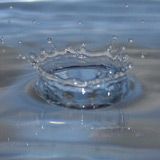 Water. Water does everything, absolutely everything. Use clean water to wash your hands, but also use clean, distilled water to clean your dog’s ears. If you don’t have dog ear-cleaning solution on hand, you can safely use clean water to help flush out dog ears to help prevent infection. And then you can wash your hands with it after to get the dog ear gunk smell off.
Water. Water does everything, absolutely everything. Use clean water to wash your hands, but also use clean, distilled water to clean your dog’s ears. If you don’t have dog ear-cleaning solution on hand, you can safely use clean water to help flush out dog ears to help prevent infection. And then you can wash your hands with it after to get the dog ear gunk smell off.